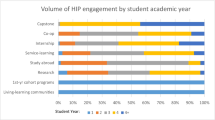Abstract
A 2010 paper published in Higher Education investigated the relationship between South African Grade 12 students’ programme preferences in 2001 for study in higher education, student enrolment in higher education programmes in 2002, and student graduations in 2006, devising what the author dubbed a preference-enrolment-graduation (PEG) model. The current paper, while recognizing the value of that model, points up its design limitations, proposing an alternative methodology for comparing student preferences, enrolments, and graduations that, using centralised Higher Education Management Information System (HEMIS) student record data, tracks the 2005 cohort of Grade 12 students along their higher education trajectories for the next 5 years (2006–2010), investigating the consistency of choice between programme preference, enrolment, and graduation.
Similar content being viewed by others
Notes
LSAY is a programme managed by the National Centre for Vocational Education and Research on behalf of the Australian Government Department of Education, Employment and Workplace Relations.
Personal communication with Jean Skene, Director of HEMIS in the South African Department of Higher Education and Training.
References
Badsha, N. (2011). PowerPoint presentation to the National Planning Commission Human Condition Seminar, Pretoria, 28–29 March.
Bhorat, H., Mayet, N., & Visser, M. (2009). Student graduation, labour market destinations and employment earnings. In M. Letseka, M. Cosser, M. Breier, & M. Visser (Eds.), Student retention and graduate destination. Higher education and labour market access and success (pp. 97–124). Cape Town: HSRC Press.
Blossfeld, H.-P., Schneider, T., & Doll, J. (2009). Methodological advantages of panel studies: Designing the New National Educational Panel Study (NEPS) in Germany. Journal for Educational Research On-line, 1(1), 10–32.
Boudon, R. (1974). Education, Opportunity and Social Inequality. New York: Wiley.
Cosser, M. (2009). Studying ambitions: Pathways from grade 12 and the factors that shape them. Cape Town: HSRC Press.
Cosser, M. (2010). The skills cline: Higher education and the supply-demand complex in South Africa. Higher Education, 59(1), 43–53.
Cosser, M., & du Toit, J. (2002). From school to higher education? Factors affecting the choices of grade 12 learners. Cape Town: HSRC Publishers.
Cosser, M., du Toit, J., & Visser, M. (2004). Settling for less: Student aspirations and higher education realities. Cape Town: HSRC Publishers.
Cosser, M., Kraak, A., & Winnaar, L. (2011). Further education and training (FET) colleges at a glance in 2010. FET colleges audit, May–July 2010. Pretoria: Human Sciences Research Council.
Cosser, M., & Sehlola, S. (2009). Ambitions revised: Grade 12 learner destinations 1 year on. Cape Town: HSRC Press.
Coleman, J. S. (1981). Longitudinal data analysis. New York: Basic Books.
DBE (Department of Basic Education). (2011). Report on the National Senior Certificate examination results 2010. Pretoria.
DoE (Department of Education). (2001). National plan for higher education. Pretoria.
Dwyer, P., & Wyn, J. (2001). Youth, education and risk: Facing the future. London: Routledge Falmer.
Halaby, C. N. (2004). Panel models for the analysis of change and growth in life course studies. In J. T. Mortimer & M. J. Shanahan (Eds.), Handbook of the life course (p. 503). New York: Kluwer Academic/Plenum Publishers.
Howie, S., Venter, E., Van Staden, S., Zimmerman, L., Long, C., Scherman, V., et al. (2007). Progress in International Reading Literacy Study (PIRLS) 2006 summary report: South African children’s reading literacy achievement. Pretoria: University of Pretoria.
JET (Joint Education Trust Education Services). (2011a). Size and shape: Post-school, pre-higher education, training and skills development landscape. Presentation by Dr Anthony Gewer to the National Planning Commission Human Condition Seminar, Pretoria, 28-29 March.
JET. (2011b). Education and Training in South Africa. Review commissioned by the National Planning Commission. Draft Report. 21 April.
Marks, G. N. (2007). Completing university: Characteristics and outcomes of completing and non-completing students. Longitudinal Surveys of Australian Youth Research Report 51. Victoria, Australia: Australian Council for Educational Research.
McInnes, C., James, R., & Hartley, R. (2000). Trends in the first year experience. Evaluations and Investigations Programme, Higher Education Division. Canberra: Australian Government Publishing Service.
McInnis, C. (2001). Signs of disengagement? The changing undergraduate experience in Australian universities. Inaugural professorial lecture. Melbourne: Faculty of Education, University of Melbourne.
McMillan, J. (2005). Course change and attrition from higher education. Longitudinal Surveys of Australian Youth Research Report 39. Victoria, Australia: Australian Council for Educational Research.
NPC (National Planning Commission). (2012). Human conditions diagnostic. In National Planning Commission Diagnostic. Retrieved on 30 April 2013 from: http://www.npconline.co.za/MediaLib/Downloads/Home/Tabs/Diagnostic/Diagnostic_Human_conditions.pdf.
Reddy, V. (2006). Mathematics and science achievement at South African schools in TIMSS 2003. Cape Town: HSRC Press.
Robinson, R. (2004). Pathways to completion: Patterns of progression through a university degree. Higher Education, 47(1), 1–20.
Van den Berg, S. (2011). PowerPoint presentation to the National Planning Commission Human Condition Seminar, Pretoria, 28–29 March.
Walstab, A., Golding, B., Teese, R., Charlton, M., & Polesel, J. (2001). Attrition and wastage in tertiary education: Report. Canberra: Lifelong Learning Network, University of Canberra.
Williams, C. (1982). The early experience of students on Australian university campuses. Sydney: University of Sydney.
Author information
Authors and Affiliations
Corresponding author
Rights and permissions
About this article
Cite this article
Cosser, M., Nenweli, S. “We’ve got you pegged”: programme choice in the transition to, and passage through, higher education. High Educ 67, 333–348 (2014). https://doi.org/10.1007/s10734-013-9655-3
Published:
Issue Date:
DOI: https://doi.org/10.1007/s10734-013-9655-3




